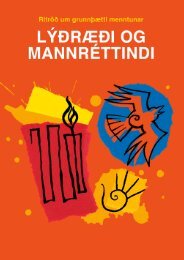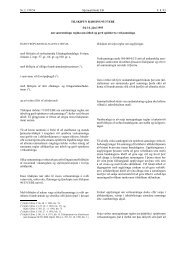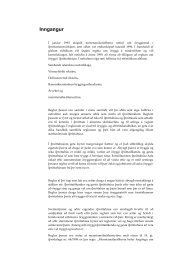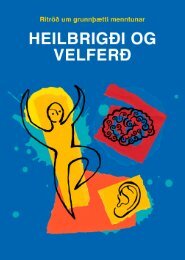Arts and Cultural Education in Iceland : Professor Anne Bamford
Arts and Cultural Education in Iceland : Professor Anne Bamford
Arts and Cultural Education in Iceland : Professor Anne Bamford
You also want an ePaper? Increase the reach of your titles
YUMPU automatically turns print PDFs into web optimized ePapers that Google loves.
Chapter 4: Other factors<br />
4.1 <strong>Education</strong> <strong>in</strong> <strong>and</strong> through the arts<br />
‣ There is a difference between, what can be termed, education <strong>in</strong> the arts (e.g.<br />
teach<strong>in</strong>g <strong>in</strong> f<strong>in</strong>e arts, music, drama, crafts, etc.) <strong>and</strong> education through the arts (e.g.<br />
the use of arts as a pedagogical tool <strong>in</strong> other subjects, such as numeracy, literacy <strong>and</strong><br />
technology)<br />
‣ Schools need strong programmes <strong>in</strong> the arts AND artistic <strong>and</strong> creative ways to learn <strong>in</strong><br />
an <strong>in</strong>tegrated way across the curriculum<br />
‣ Teachers are unclear about the aims <strong>and</strong> specific learn<strong>in</strong>g embedded <strong>in</strong> the arts<br />
‣ Cont<strong>in</strong>uity is vital if arts education is to have an impact especially between the various<br />
levels of education<br />
‣ The creative <strong>in</strong>dustries <strong>in</strong> Icel<strong>and</strong> are call<strong>in</strong>g for more creative approaches to education<br />
There were very high quality examples of schools that adopted flexible approaches to the<br />
delivery of curriculum. In these situations, learn<strong>in</strong>g philosophies were grounded around<br />
connected learn<strong>in</strong>g. Adopt<strong>in</strong>g mean<strong>in</strong>gful thematic learn<strong>in</strong>g, they tended to relate learn<strong>in</strong>g<br />
across curriculum areas. This approach was particularly strong <strong>in</strong> the pre-primary school.<br />
A comprehensive study conducted <strong>in</strong> 2004 19 implored schools <strong>and</strong> the broader educational<br />
sector to commence arts education early <strong>in</strong> a child’s life <strong>and</strong> ensure there was cont<strong>in</strong>ued<br />
development of creative <strong>and</strong> cultural competencies throughout the entire school programme.<br />
The report cautions strongly that “With<strong>in</strong> the entire educational trajectory the concept of<br />
creativity must be central” In some schools <strong>in</strong> Icel<strong>and</strong> learn<strong>in</strong>g has effectively been mapped<br />
across the school <strong>and</strong> with<strong>in</strong> particular school years. Consistent <strong>and</strong> cont<strong>in</strong>uous experiences are<br />
vital if a child is to develop fully their artistic languages. This is ma<strong>in</strong>ly achieved through us<strong>in</strong>g<br />
education through the arts <strong>in</strong> an <strong>in</strong>tegrated way, as these quotes from a range of schools<br />
suggest:<br />
Whenever there is an opportunity to use the arts or teach through the arts we use it.<br />
Need to <strong>in</strong>tegrate the arts (why don’t we draw mathematics?<br />
This school is a board<strong>in</strong>g school located <strong>in</strong> an isolated part of Icel<strong>and</strong>. It was just under 200 pupils from preprimary<br />
school to secondary school. Adults also have the option to study <strong>in</strong> the school.<br />
The arts are seen as the element to connect people together. They have dance, music, visual arts, textile <strong>and</strong><br />
woodwork. The teachers are encouraged to work across discipl<strong>in</strong>es at least a few hours per week.<br />
We are try<strong>in</strong>g to make this offer. Really though it is only done <strong>in</strong> special weeks such as the annual festival, then<br />
everyth<strong>in</strong>g is <strong>in</strong>tegrated.<br />
We have a new pr<strong>in</strong>cipal that really encourages <strong>in</strong>tegrated learn<strong>in</strong>g. For example, the Icel<strong>and</strong>ic teacher is work<strong>in</strong>g<br />
with a poet. We are look<strong>in</strong>g for professional development courses <strong>in</strong> this way of work<strong>in</strong>g.<br />
There was a need expressed for not only more education through the arts, but also for the walls<br />
between discipl<strong>in</strong>es of the arts to be removed, as this quote from a parent <strong>in</strong>dicates:<br />
I would say we have good education <strong>in</strong> the arts, but we don’t have education through the arts. There should be<br />
more of that – <strong>in</strong>tegrated teach<strong>in</strong>g, learn<strong>in</strong>g through films <strong>and</strong> so on. This way pupils, teachers, <strong>and</strong> artists can<br />
<strong>in</strong>spire one another. We need to build happy children who are open to anyth<strong>in</strong>g. We could do more teach<strong>in</strong>g<br />
around themes that cross all curriculum areas. Walls need to come down. We don’t have flexibility <strong>in</strong> the system.<br />
School is like a separate world. We are los<strong>in</strong>g site of why we are educat<strong>in</strong>g our children. We need to be<br />
19 Devos, 2004) p 2<br />
88


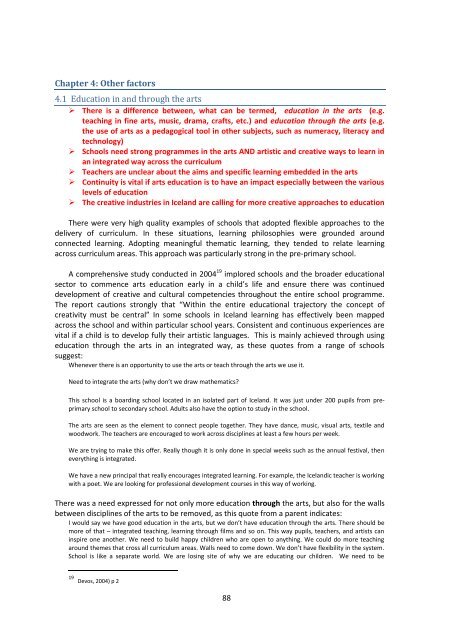
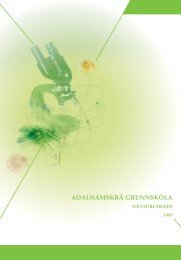
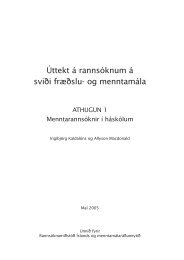

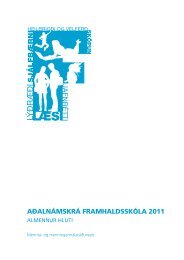
![Aðalnámskrá tónlistarskóla : rytmÃsk tónlist [Eingöngu á rafrænu formi]](https://img.yumpu.com/50843672/1/184x260/aaalnamskra-tanlistarskala-rytma-sk-tanlist-eingangu-a-rafranu-formi.jpg?quality=85)
